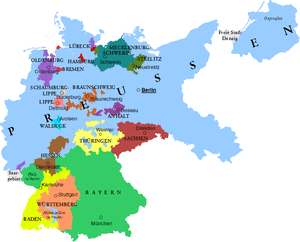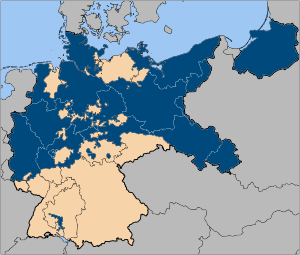Administrative divisions of Weimar Germany
Prior to World War I, the constituent states of the German Empire were 22 smaller monarchies, three city-states and the Imperial territory of Alsace-Lorraine. After the territorial losses of the Treaty of Versailles and the revolution of 1918, the remaining states continued as republics. The former Ernestine duchies continued briefly as republics before merging to form the state of Thuringia in 1920, except for Saxe-Coburg, which became part of Bavaria.
Länder (states, republics)

| State (German name) | Capital | |
|---|---|---|
| |
Anhalt | Dessau |
| |
Baden | Karlsruhe |
| |
Bavaria (Bayern) | Munich |
| |
Brunswick (Braunschweig) | Braunschweig |
| |
Hesse (Hessen / Hessen-Darmstadt) | Darmstadt |
| |
Lippe | Detmold |
| |
Mecklenburg-Schwerin | Schwerin |
| |
Mecklenburg-Strelitz | Neustrelitz |
| |
Oldenburg | Oldenburg |
| |
Prussia (Preußen) | Berlin |
| |
Saxe-Coburg (Sachsen-Coburg) – to Bavaria in 1920 | Coburg |
| |
Saxony (Sachsen) | Dresden |
| |
Schaumburg-Lippe | Bückeburg |
| |
Thuringia (Thüringen) – from 1920 | Weimar |
| |
Waldeck-Pyrmont – to Prussia in 1921/1929 | Arolsen |
| |
Württemberg | Stuttgart |
| City-states | ||
| |
Bremen | |
| |
Hamburg | |
| |
Lübeck | |
| States merged to form Thuringia in 1920 | ||
| |
Reuss | Gera |
| |
Saxe-Altenburg (Sachsen-Altenburg) | Altenburg |
| |
Saxe-Gotha (Sachsen-Gotha) | Gotha |
| |
Saxe-Meiningen (Sachsen-Meiningen) | Meiningen |
| |
Saxe-Weimar-Eisenach (Sachsen-Weimar-Eisenach) | Weimar |
| |
Schwarzburg-Rudolstadt | Rudolstadt |
| |
Schwarzburg-Sondershausen | Sondershausen |
These states were gradually de facto abolished under the Nazi regime via the Gleichschaltung process, as the states were largely re-organised into Gaue. However, the city-state of Lübeck was formally incorporated into Prussia in 1937 following the Greater Hamburg Act - apparently motivated by Hitler's personal dislike for the city. Most of the remaining states were formally dissolved by the Allies at the end of World War II and ultimately re-organised into the modern states of Germany.
Prussian provinces

After the fall of the German Empire the Kingdom of Prussia was reconstituted with a republican government as the Free State of Prussia. It had to cede virtually all territory belonging to the provinces of Posen and West Prussia to the newly created state of Poland. Prussia and its provinces formally continued to exist even though political control was eventually taken over by the National Socialist German Workers Party following their rise to power in 1933. Both Prussia and Nazi Germany was finally dissolved following the end of World War II in 1945.
- Berlin (in 1920 the city was considerably extended (Prussian Greater Berlin Act) on the expense of Brandenburg)
- Brandenburg
- East Prussia
- Hanover
- Hesse-Nassau
- Hohenzollern
- Lower Silesia (Part of Silesia between 1938 and 1941)
- Pomerania
- Posen-West Prussia (Created in 1922 from the parts of the provinces Posen and West Prussia that had not been ceded to Poland, the province was dissolved in 1938 with its territory being mainly incorporated into Pomerania, and two exclaves into Brandenburg and Silesia.)
- Rhine Province
- Saxony
- Schleswig-Holstein
- Upper Silesia (Part of Silesia between 1938 and 1941)
- Westphalia
Nazi era
Though the Länder and Prussian provinces continued to exist officially after the Enabling Act of 1933, they were adapted to the Nazi party Gaue after 1934, which became their de facto successors.
References
- Solsten, Eric (1999). Germany: A Country Study. DIANE Publishing Company. ISBN 0-7881-8179-3.